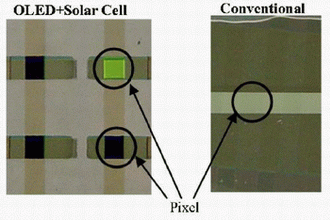Scientists at National Taiwan University have found a way to improve the contrast by integrating OLEDs with solar cells. Not only do solar cells positioned behind an OLED provide a contrast superior to that achieved with polarizers, but they can also recycle energy that is usually wasted.

The scientists explain that OLEDs generally consist of a reflective back electrode, organic layers, and a semi-transparent electrode for light to exit. The reflective back electrode means that the device constantly reflects light, even when the device is off, and degrades the contrast when the display is on. Previous approaches to reduce the ambient light reflection and enhance the contrast result in lost energy from both the incident photons and the stifling of some internal OLED emission.

